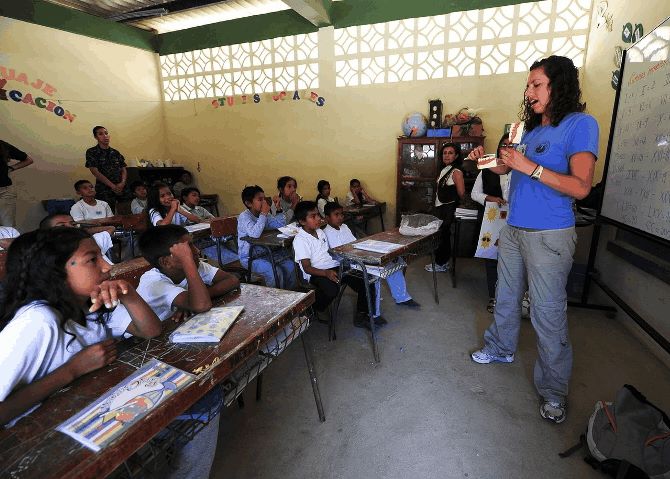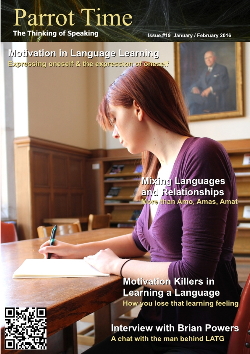Motivation
Expressing oneself and the expression of oneself in language learning
|
Section II a few tips: If motivation is an integral part of your identity, here are three things which can help motivating students. First, it follows logically that teaching someone how to express who they are in the target language feeds their desire to improve their skills. Secondly, there has to be space in the classroom for the students to express themselves. The instruction cannot be teacher centred, otherwise, how is the student ever to negotiate their own position? Standard language, yes, but real language too!! One of the most motivating things about learning a language is getting to the point where you can have a conversation with a native speaker, during which they do not need to slow down or adapt their language. If a native speaker engages with you in that manner, they see you as competent, as a "linguistic peer", they recognise that you are part of their language community. You may have an accent that identifies you as a foreigner, but remember that languages transcend political and geographical boarders – just consider that there are many more non-native English speakers on the planet than native speakers, many of whom are considered to have mastered English language like few native speakers have (Kissinger is a famous example). By and large, the language used in authentic conversation is fairly different to the language you are taught in formal classes. If you have spent years in language classes before travelling to the countries where the language is spoken, you might have been shocked at the differences between your perception of that language and the actual language spoken by native speakers. Here's a couple of examples for the French learners: The word il (he) is more commonly pronounced /i/, by about 10 to 1. That's a small one, but it could easily throw you off in the course of a group conversation or in case of an expression you learn in the first few weeks of learning: il y a (there is). What are the chances that you will understand this expression when in non-careful spoken language, many will pronounce it ya? A second one is the negative. Here are three versions of "it's not raining" in French: • Il ne pleut pas• Il pleut pas • Il ne pleut  What is the proper way to say "It's not raining" in French? Remember working on the inclusion of ne before the verb and pas after it? Il ne pleut pas changes to ipleupa in non-careful speech. If you were lucky enough to have noticed that ne deletion, and you are now advanced in your communicative competence, you may read 19th century novels, in which, lo and behold, the pas is frequently deleted! Il ne pleut. Ok, so these are to some extent just technical issues that one can learn. So here's the biggie. You learn that using vous is polite and tu is informal. THEN you travel to France, and you realise that it is in fact much more complex, that the French expect a certain "je ne sais pas", so that your interlocutor can redirect the register, thus establishing a friendship between the speakers. It looks like this: • Oh bonjour, comment allez-vous? (Oh hello, how are you?) • Ça va, ça va ; on peut se tutoyer, quand même, non? (Ok, ok; we can say "tu" to each other, can't we?) So here on, you may say tu to your interlocutor. However, at which point can you start doing the famous French bise (the kiss). If you get friendly enough for the bise, the conundrum is not yet over. How many. In my little Swiss village, it's three. In many Southern French regions, it two, around Paris, four, but not in Paris itself. Give the wrong number and you may be surprised to find that you have offended your new friend! These difficulties can be daunting, or can be considered a challenge by the learner. The aim is not that the classroom provides knowledge of all the communicative subtleties. But no knowledge in those has the double disadvantage of not providing students with the ability to express themselves across different registers, and being unprepared for an eventual trip to the country of the target language. Knowing the standard variation of a language is useful, there's no doubt. As non-native, you might be fluent enough to have a conversation with anyone. Standard language is also useful for teachers, as it provides them with material common to all learners and thus an assessment benchmark. However, there is a real issue of self-representation when learners do not know how to navigate registers. Bilingual people often talk of being a different person when they speak a different language. This is because most are not as comfortable in each language they speak and are therefore unable to represent themselves in the same way. There are other issues, of course, including how languages express similar ideas in very different ways, are culturally biased and so forth. Still, expressing oneself in the standard language alone seriously limits self-representation. Thus if motivation is closely related to the expression of oneself, a better-rounded presentation of oneself can only help. Chalk and Talk/be quiet and listen/open your book etc At least some of what is taking place in classrooms is still based on the old fashion chalk and talk. I am guilty of this too. However much I try to encourage my students to take some ownership in their learning, it's still far too easy to ask students to copy a vocabulary list or to write down grammar examples, followed by a cloze test. When either my students or I are tired, it's a solution that limits disruptive behaviour. Because it's clear that people learn better when we suppress who they are. I'm exaggerating a bit here. High school education in Australia is not as strict and inflexible as I suggest, but there certainly are elements of it.  Teaching a language needs to be more interactive, not with a single teacher talking while no students talk A common mistake made by teachers is to request complete silence in their classes. Sure, it looks great from the outside, a group of students listening intently while a teacher is dispensing their wisdom. However, if students are not being allowed to have an active role in their own learning, they will not be able to make connections with the target language. It looks like I'm blaming teachers here, but students are just as guilty! The majority of the time students are too anxious to speak up, even when the instructional model is student centred. Think about this expression "student centred" for a second. What pressure on a language novice! Of course, no teacher in their right mind would simply pass the instruction responsibility entirely to their students. But those moments when the spotlight is on the learner really has the potential to freak them out. The point is that the teacher and the students have to negotiate, and break the two sided school bench paradigm: it's not the students on one side and the teacher on the other. If that was the case, how insulting for students to be all put in the same basket! One identity for all! Language learning is a courageous endeavour for everyone. The learners all need to speak up through their anxiety and the teachers all need to relinquish some control. I would love to be able to say more about how this negotiated classroom looks, but in truth, I believe that the negotiation permeates through the entire year or years of formal classes. I realise that I am positioning myself as an enemy of pedagogy, but I truly believe that the key to a successful class environment is the constant and every day scrutiny of my relationship with each of my students, accepting that I will not cater for everyone's comfort, and nor should I. |
| Motivation: Expressing oneself and the expression of oneself in language learning | ||||||
| Writer: | Olivier Elzingre | |||||
| Images: | ||||||
| ||||||
| Sources: | ||||||
| ||||||
All images are Copyright - CC BY-SA (Creative Commons Share Alike) by their respective owners, except for Petey, which is Public Domain (PD) or unless otherwise noted.
comments powered by Disqus
















